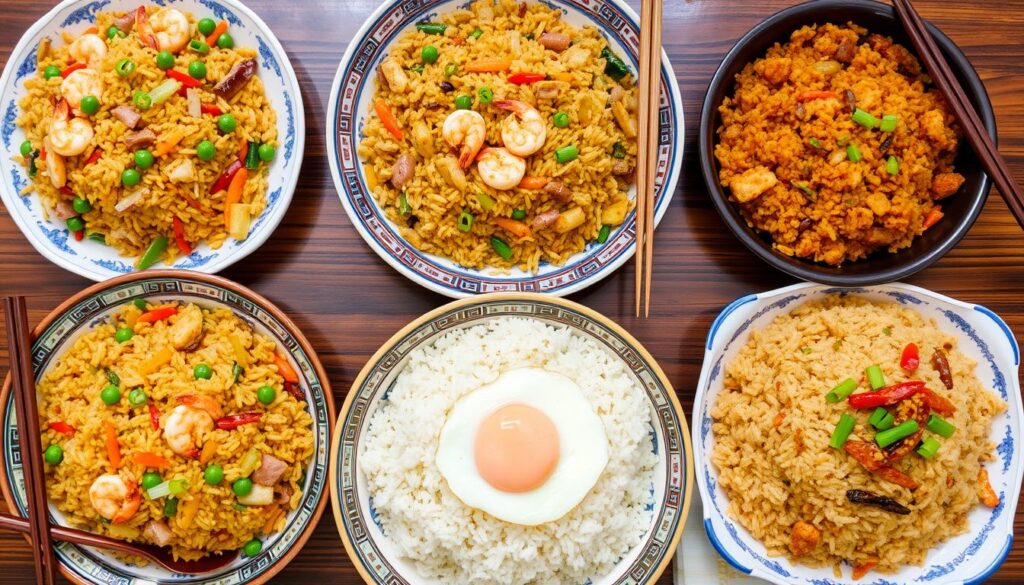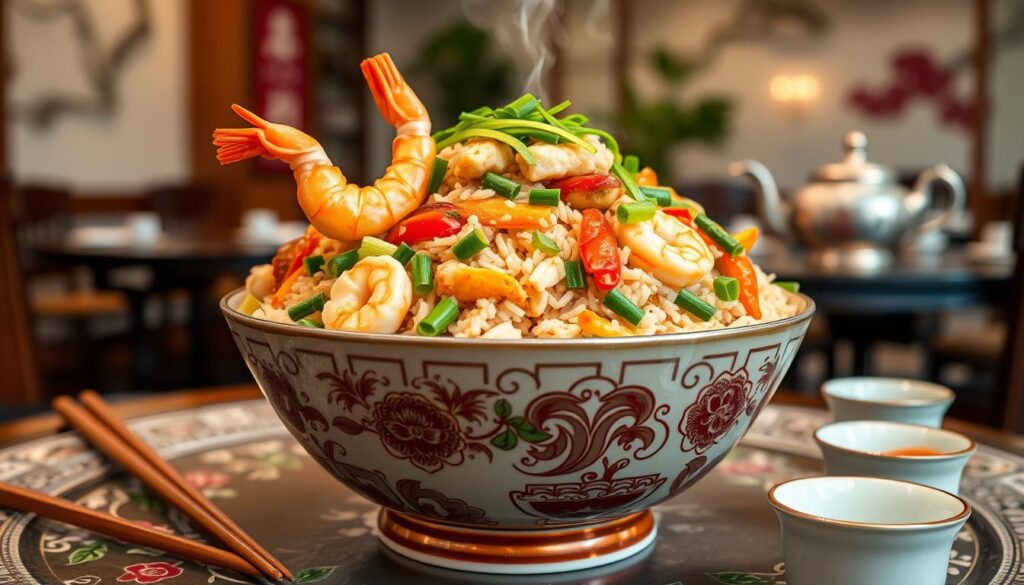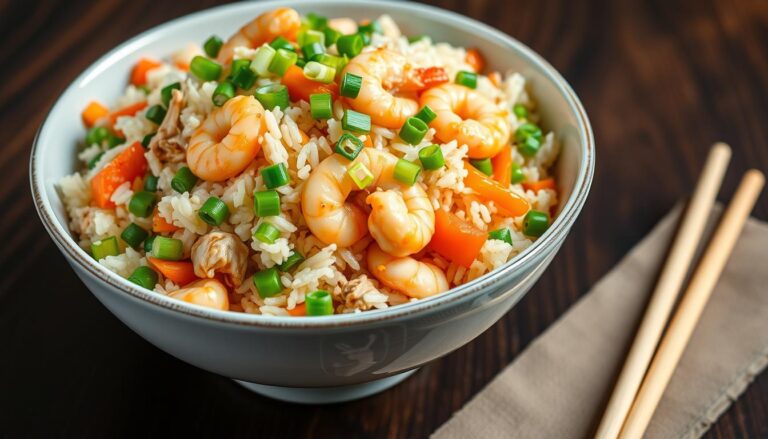Did you know a top dish in Chinese cuisine was once fit for an emperor? Young-Chow fried rice brings centuries of kitchen art to our tables. It has moved from royalty to a worldwide family favorite. But what is the secret history behind it? How did it become a key part of comfort food culture?
It traveled from the affluent Qing Dynasty to your local take-out. This journey shows cultural exchange, evolving tastes, and creative cooking. Starting in Yangzhou, it has become a key symbol of Chinese food around the world. With simple parts like shrimp, cured ham, eggs, and scallions, Young-Chow fried rice shows beauty in simplicity. It wins overcooks and food lovers with its flexible and tasty flavors.
Key Takeaways
- The regal origins of Young-Chow fried rice from the Qing dynasty.
- The shift from a royal treat to a versatile world Chinese food staple.
- The main parts of traditional Young-Chow fried rice are shrimp and cured ham.
- The perfect dish for a quick, satisfying family meal, ready in under an hour.
- Nutritional benefits include a rich taste with proteins and essential vitamins.
- Using day-old rice makes the ideal texture and flavor absorption.
- With over 34,490 shares, Young-Chow fried rice is a loved choice in China and beyond.
Exploring the History of Young-Chow Fried Rice
The story of Young-Chow fried rice starts in Yangzhou, Jiangsu Province. It’s well-known in Chinese cuisine and loved worldwide as comfort food. This dish highlights the history of Young-Chow fried rice and its ties to Chinese culture.
The Origins in Yangzhou, Jiangsu Province
Yangzhou is where Young-Chow fried rice originated. It’s key to the Huaiyang culinary tradition, one of the region’s oldest. The city’s food is celebrated for its freshness and flavors, affecting cuisines in China and beyond.
The Qing Dynasty and the Evolution of the Dish
In the Qing Dynasty, Young-Chow fried rice evolved into a gourmet dish. It began to include fancy ingredients like shrimp and cured ham. Cooking became an art, reflecting the dynasty’s wealth.
The Transformation from Imperial Cuisine to Take-Out Favorite
Young-Chow fried rice went from royal cuisine to a global take-out favorite. This change signifies the dish’s ongoing food legacy, as it shows the dish’s journey from lavish feasts to everyday meals.
Young-Chow fried rice is known for its unique flavor and texture. It has kept its core qualities through years of cooking improvements. To learn about traditional Chinese cooking, check out Uncle Roger’s fried rice recipe here. It showcases the basic ingredients and techniques of Asian cuisine.
| Ingredient | Nutritional Information per Serving |
|---|---|
| 6 cups cooked white rice | Calories: 301, Carbs: 49g, Protein: 7g, Fat: 8g |
| 1 cup chopped barbecued pork | Sodium: 1043mg (43% daily intake) |
| Seasonings (soy sauce, ginger, garlic) | Enhances flavor profile, minimal caloric addition |
A Step-by-Step Guide to Authentic Young-Chow Fried Rice
If you love quick meals with lots of flavors, try the Young-Chow fried rice recipe. It’s a famous dish that mixes traditional Asian recipes with the popular stir-fry dishes loved around the world.
Start with dry day-old jasmine rice. This helps the rice stay firm and separate, which is key for great fried rice. Heat 2-4 tablespoons of neutral oil in a carbon steel wok for even cooking.
Add 4 beaten eggs into the wok, scrambling them lightly. Then mix in 1/2 diced onion and 4 chopped Chinese sausages. Throw in 4 ounces of shrimp until they’re pink, adding that special taste.
Combine everything with 4 cups of rice. Flavor it with 1 teaspoon of salt or soy sauce to suit your taste. For a true Chinese flavor, try adding Shaoxing wine, found in traditional recipes.
Finish your dish with sliced green onions and optional shredded lettuce. The onions add a spicy touch, balancing the dish. In about 15 minutes, you’ll have a delicious Young-Chow fried rice. It’s a perfect example of how quick meals can still bring the rich taste of Asian recipes to your table.
| Ingredient | Quantity | Description |
|---|---|---|
| Neutral oil | 2-4 tbsp | For cooking |
| Eggs | 4 large | Lightly beaten |
| Chinese sausages | 4 links | Diced, about 1 cup |
| Onion | 1/2 medium | Diced |
| Shrimp | 4 ounces | Raw, small, peeled, and deveined |
| Cooked rice | 4 cups | Day-old, preferable |
| Salt/Soy sauce | 1 tsp | Adjustable to taste |
| Green onions | 2 | Thinly sliced for garnish |
| Lettuce | 1-2 cups | Shredded, optional |
This Young-Chow fried rice recipe is a great mix of traditional and global tastes. It’s perfect for any cook, beginner or pro. Every bite is a new discovery of flavors, making it a dish to enjoy over and over.
The Crucial Ingredients of Young-Chow Fried Rice
Making the perfect Young-Chow fried rice starts with the right ingredients. This comfort food is not only tasty but also quick to make. Let’s dive into what makes this dish a favorite for many.
The key base is day-old rice because it’s firm and not mushy. Fresh rice might make the dish too soft. The dish has shrimp, Chinese sausages, and sometimes chicken or pork. This mix adds a rich taste.
It also has green peas, green onions, and carrots. These add color and health benefits. You can even make it vegetarian by adding more veggies. Soy sauce, sesame oil, and white pepper make it extra tasty. These seasonings are crucial for that comfort food feel.
| Ingredient | Percentage |
|---|---|
| Day-old Cooked Rice | 35% |
| Eggs | 11% |
| Chopped Char Siu/Red Pork/Chinese Sausage | 8% |
| Shrimps | 16% |
| Green Peas | 2.5% |
This dish is fast to make, taking about 15 minutes. It’s perfect for a quick, tasty dinner and a great choice for any meal when you need something satisfying and quick.
In summary, the success of Young-Chow fried rice depends on the right mix of ingredients. Stick to the classic or try a vegetarian twist. The ingredients you pick are key to creating a welcoming and warm meal.
Perfecting the Rice: The Base of Young-Chow Fried Rice
Perfectly prepared rice is the start of delicious Young-Chow fried rice. It can be part of a family meal or a favorite on take-out menus. The rice’s texture is crucial to the success of this popular Asian dish. Here are some tips to make sure your rice turns out just right for stir-fry.
Tips on Cooking and Drying the Rice for Stir-fry
When cooking rice for Young-Chow fried rice, adjusting the water ratio is key. Normally, you’d cook rice with twice as much water, but for stir-frying, less water means firmer, less sticky grains. For the perfect texture, use about 1¾ cups of water for each cup of rice. After cooking, spread the rice to air-dry or use a fan. This step is vital but often missed.
Why Leftover Rice Makes the Best Fried Rice
Leftover rice from the fridge is perfect for making Young-Chow fried rice. Overnight, the low temperature dries the rice, creating a firm texture. This texture prevents the grains from sticking and lets each grain soak up the flavors and seasonings. Many cooks and chefs who specialize in Asian recipes prefer using leftover rice.
Below is a table showing typical cooking times and techniques for Young-Chow fried rice. This dish is a must-have in Asian take-out and family dining. It’s not just about fresh ingredients but also how you prepare and cook the rice.
| Ingredient | Preparation | Cooking Time |
|---|---|---|
| Garlic | Minced | 3 minutes |
| Rice | Stirred | 5 minutes |
| Shrimp and Char Siu | Stir-fry with other ingredients | 2 minutes |
| Mixed ingredients (final) | Combine and stir-fry | 3 minutes |
This approach respects traditional methods and fits well with the fast pace of modern life. Great Young-Chow fried rice comes from not only fresh ingredients but also how well you prepare the rice.
Mastering the Wok: Techniques for the Best Young-Chow Fried Rice
It’s vital to get the cooking techniques right to enjoy the exceptional taste and texture of Young-Chow Fried Rice. This comfort food isn’t just tasty; it challenges you to perfect your work skills.
Getting your ingredients ready before you start is key. Make sure to chop scallions and beat eggs before you turn on the heat. Every ingredient, from the crispy sausages to the cooled rice, needs to be added at the right time.
It is very important to heat the wok properly. Preheat it until it smokes, then add oil that can handle high heat. This helps quickly sear foods, like sausages, adding a smoky flavor.
If you’re adding shrimp, putting them in at the right moment is important to prevent overcooking. Adding things quickly and at the correct times keeps the high heat going for a great stir-fry.
Stir-frying is all about keeping the food moving. You need to push, toss, or stir so each rice grain gets crispy but not burnt.
| Ingredient | Preparation | Notes |
|---|---|---|
| Laap Cheung Sausages | Dice and cook until crisp | Provides a meaty texture and rich flavor |
| Scallions | Slice and add near the end | Adds freshness and a slight sharpness |
| Cooked Chilled Rice | Fluff and separate grains before adding | Older, day-old rice is recommended for less moisture |
| Iceberg Lettuce | Chop and stir in the last | Gives crunch and lightness to the dish |
Success means having a hot wok and moving quickly. This detailed guide will help you learn more about hibachi methods and improve your cooking techniques.
Don’t put too many things in the wok at once. This ensures ingredients like shrimp and sausage cook perfectly. It’s what makes Young-Chow Fried Rice so special in Chinese cuisine.
Young-Chow Fried Rice Versus Other Chinese Rice Dishes
Exploring Chinese cuisine introduces us to a wide array of rice dishes. Young-Chow Fried Rice shines through. It’s not just comfort food but also a top pick for takeout.
What makes Young-Chow Fried Rice stand out? It’s the rich array of ingredients and how it’s made. Unlike the simpler Cantonese version, which has just peas, egg, and onions, Young-Chow packs in shrimp, chicken, and char siu pork.
Comparing Flavors: Young-Chow vs. Cantonese Fried Rice
The flavor of Young-Chow Fried Rice is rich and complex, benefiting from a mix of ingredients. Cantonese fried rice, however, offers subtlety. It’s known for its fresh, natural taste from fewer ingredients. Young-Chow is heartier and celebrated for its bold use of meats and seafood.
Distinguishing Ingredients and Regional Variations
Different areas tweak Chinese cuisine to fit local tastes, including fried rice. Young-Chow features eggs, pork, chicken, and shrimp, which are made savory with soy sauce. Sometimes, scallions add a fresh garnish.
In places like the Philippines, local tweaks are added to fried rice. These can include local sausages and spices. Such changes keep the dish exciting yet familiar. It shows how Chinese fried rice has been adopted worldwide.

Both Young-Chow and regional fried rice have their places in Chinese cuisine. Yet, Young-Chow’s rich ingredients and comforting touch make it particularly loved. It’s a prime choice for comfort food and take-out.
Adapting Young-Chow Fried Rice to Dietary Preferences
In the world of Chinese cuisine, Young-Chow fried rice is known for being adjustable. It’s ideal for those looking for vegetarian recipes. They don’t miss out on true flavors. By using tofu or various veggies instead of meat, anyone can enjoy this dish within their dietary limits.
Want quick meals? Young-Chow fried rice is your answer. By adding mushrooms, baby corn, or water chestnuts, you get a dish that’s easy and quick. It stays true to Chinese cuisine but fits the rush of today’s life.
| Ingredient | Original | Vegetarian Option |
|---|---|---|
| Protein | Shrimp or Chicken | Tofu or Tempeh |
| Vegetables | Carrots, Peas | Baby Corn, Water Chestnuts |
| Base | Rice | Brown Rice or Quinoa |
Making Young-Chow fried rice fit different dietary preferences doesn’t mean flavor loss. It’s about improving the dish for health or ethical choices. This way, everyone can enjoy a tasty meal that respects their diet and saves time.
Pairing Suggestions: What to Serve with Young-Chow Fried Rice
The intricate flavors and rich textures of Young-Chow fried rice make it a great choice for family meals. It fits well with many Asian recipes. Here are some top pairing suggestions to make your at-home take-out food experience or dinner unforgettable.
Complementary Side Dishes for a Complete Meal
Young-Chow fried rice tastes best with light and refreshing sides. A simple bok choy and tofu soup cleanses the palate, and a smashed cucumber salad provides a crisp contrast.
If you like something crunchy, try adding deep-fried shallots or pork floss. These enhance the meal, creating a perfect flavor mix with the fried rice.
Recommended Chinese Soups and Appetizers
Starting with soups, hot and sour or egg drop soup pairs well. They prepare your taste buds for the main dish. For appetizers, consider tangy lemon chicken or tender gyoza dumplings. These options bring diverse flavors that go great with the rice.
Adding these to your Asian recipes will surely impress, whether you’re serving a family meal or hosting a dinner.

For a more robust dinner, why not try fusion dishes? Wonton tacos or kung pao chicken wings offer a modern twist and make your meal stand out.
| Suggested Side Dish | Type | Ideal Pairing Beverage |
|---|---|---|
| Chinese broccoli | Vegetable | Green tea |
| Chili paneer gravy | Appetizer | Chilled Moscato d’Asti |
| Chicken Manchurian | Main Course | Bold Red Wine |
| Dumplings | Appetizer | Champagne |
| Malanga fritters | Snack | Light Beer |
Choosing the right pairing suggestions for Young-Chow fried rice is more than just about taste. It turns a meal into a chance to dive into both traditional and modern Asian recipes. These pairings are sure to please anyone, whether for a small family meal or a big party.
Conclusion
Chinese cuisine shines with Young-Chow fried rice. Its roots deeply touch the culture of Yangzhou. It’s not just tasty—it symbolizes wealth and luck. Emperors during the Ming Dynasty enjoyed this rich, flavorful dish. Now, it’s comfort food that brings people together.
Young-Chow fried rice adapts to many diets. It offers healthy family meals, including low-carb and gluten-free. Whether at Peking Garden or at home, it’s flexible. You can enjoy the traditional taste or tweak it to fit your needs.
The making of Young-Chow fried rice is special. It uses day-old rice and precise spices. The stir-fry dance in a seasoned wok is key. It’s not just food—it’s a moment to cherish. This dish is a hug, a feast, and a link to Chinese cuisine‘s rich history.
FAQ
What is Young-Chow fried rice?
Young-Chow fried rice is a well-loved dish from Chinese cuisine. It’s known for its delicious mix of eggs, shrimp, ham, and scallions. This mixture is stir-fried with fluffy rice to create a comforting meal for families.
Can you tell me about the history of Young-Chow fried rice?
This dish originated in Yangzhou, Jiangsu Province, during the Qing dynasty. It was first made with high-quality ingredients for the imperial class. Now, it’s a favorite all over the world, not just for royalty.
How do you make authentic Young-Chow fried rice?
To make it authentic, you stir-fry eggs first. Then, add shrimp, onions, ham, and roast pork. Mix in cooled rice, seasoning with salt, sugar, and Shaoxing wine for extra flavor. Finally, add scallions and lettuce before serving.
What ingredients are essential for Young-Chow fried rice?
Essential ingredients include rice, oil, eggs, shrimp, onion, ham, roast pork, peas, and scallions. Lettuce adds freshness. Flavor it with salt, sugar, and white pepper. Shaoxing wine is a great optional addition.
How should the rice be prepared for Young-Chow fried rice?
Cook the rice with a bit less water so it’s not too soft. Let it cool down or chill it overnight. This ensures the grains are perfect for stir-frying.
What techniques are critical to mastering the wok for Young-Chow fried rice?
Key techniques include cooking on high heat and keeping the rice moving to avoid sticking. Heat the wok until it smokes, then add oil and your ingredients. This ensures the rice cooks evenly and stays light.
How does Young-Chow fried rice differ from other Chinese rice dishes?
Young-Chow fried rice stands out because it contains a variety of proteins, such as shrimp and ham. The special stir-frying techniques give it a unique texture and taste.
Can Young-Chow fried rice be adapted for vegetarians?
Yes! Replace meat and seafood with tofu or veggies. Add mushrooms, baby corn, or water chestnuts for flavor. This keeps the classic taste even in a vegetarian dish.
What are some good dishes to serve with Young-Chow fried rice?
It goes well with light soups, salads, and appetizers. Consider bok choy and tofu soup, cucumber salad, or deep-fried shallots. These sides make a great, complete meal.
Why is Young-Chow fried rice considered a comfort food?
It’s seen as comfort food because of its rich taste and satisfying mix of ingredients. Its versatility has made it a favorite for both home meals and take-out.

Young Chow Fried Rice Recipe
Equipment
- Wok or large skillet
- Wooden spoon or spatula
- Knife and cutting board
Ingredients
- 3 cups cooked jasmine rice preferably day-old
- 1/2 cup cooked shrimp peeled and deveined
- 1/2 cup cooked diced pork or ham
- 2 large eggs beaten
- 1/2 cup frozen peas and carrots thawed
- 2 green onions chopped
- 2 tbsp soy sauce
- 1 tbsp oyster sauce optional
- 1 tbsp vegetable oil
- 1 tsp sesame oil optional
- Salt and pepper to taste
Instructions
Prepare the Ingredients:
- Ensure all ingredients are prepped and ready to go before starting, as stir-frying moves quickly.
Scramble the Eggs:
- Heat 1/2 tablespoon of vegetable oil in a wok or large skillet over medium-high heat. Add the beaten eggs and scramble until fully cooked. Remove the eggs from the wok and set aside.
Sauté the Proteins:
- In the same wok, add the remaining vegetable oil. Add the cooked shrimp and diced pork (or ham), stir-frying for 1-2 minutes until heated through.
Stir-Fry the Vegetables:
- Add the peas, carrots, and green onions to the wok. Stir-fry for another 1-2 minutes until the vegetables are tender.
Add the Rice and Seasoning:
- Add the day-old cooked rice to the wok, breaking up any clumps. Stir-fry everything together for 3-4 minutes until the rice is evenly heated.
- Stir in the soy sauce and oyster sauce (if using), along with sesame oil. Season with salt and pepper to taste.
- Combine and Serve:
- Add the scrambled eggs back into the wok and gently toss to combine with the fried rice. Serve hot.
Notes
You can easily customize this dish by adding different proteins like chicken, beef, or tofu.
For added flavor, you can drizzle a little more soy sauce or serve with sriracha on the side.



